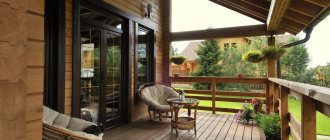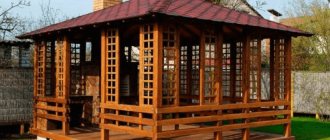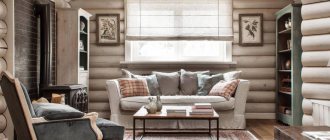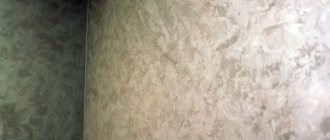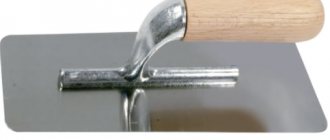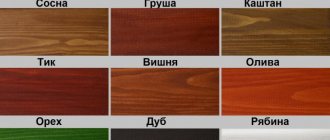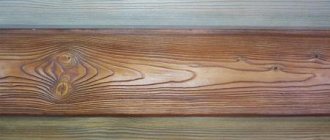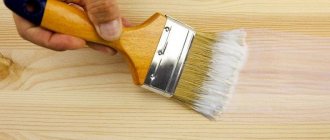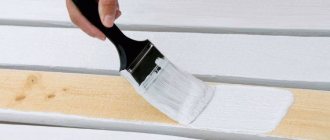Artificially aged wood is a unique finishing material. Practical, inexpensive, fully retaining its strength characteristics, but at the same time possessing original beauty and antique charm. The scope of application of such wood is wide: interior design, furniture manufacturing, finishing of facades, gazebos, stairs, even fences are made from it. The most important thing is that wood processing does not require special knowledge or experience, and anyone can do it. Let's take a closer look at how to age wood on your own, and what you need for this.
Artificially aged wood
Wood aging methods
There are three effective ways to age wood - mechanical, chemical and thermal. Depending on the chosen method, the end result has certain differences.
The mechanical method includes two types of processing - brushing and patination. Both types can be used together or separately, depending on the material and the desired result:
- brushing - the surface is treated with a wire brush to remove soft fibers and expose the annual rings. As a result of this treatment, the top layer acquires a pronounced relief, which is further emphasized by applying glaze compounds. This method is the most labor-intensive and is used mainly for hard wood - pine, larch, spruce, oak, walnut;
Wood brushing
- patination – surface treatment with coloring compounds followed by polishing. It is used for soft species, as well as wood with a weak texture - maple, cherry, beech and others. Wood wax and stain can be used along with paint to give a brighter pattern.
Patination
The chemical method involves treating the top layer of wood with various compounds that change the color of the fibers. Ammonia and products containing alkali, such as stove or drain cleaner, are suitable for this. This method can only be used for species containing tannins, that is, deciduous. Chemical treatment of coniferous wood will not give the desired effect.
The thermal method involves burning wood with a gas torch or blowtorch. The type of tree does not matter. They do not burn it too much, just so that the texture of the fibers appears more clearly, and then remove the carbon deposits with a metal brush. Next, cover the surface with stain or varnish to give the wood a more decorative appearance. In general, the process is not complicated, but it requires caution and compliance with safety precautions.
Burner-aged wood
Patina effect
Patina is a specific dark green coating that is acquired by objects made of bronze, silver, etc. under the influence of the environment.
To achieve this effect, you can use a special paint with the same name:
- First, the object must be varnished with a durable varnish, which gives the surface additional wear resistance;
- After the layer has dried, a thin colorful layer of patina is applied to the product;
- After half an hour, you can treat the product with abrasive fine-grained paper;
- The final stage is varnishing the finished product.
Coloring effect
This term refers to painting wood in several layers, which gives the products a picturesque, shabby look. For painting you need:
- Artificially apply chips, scratches and cracks to the object. In addition, you can randomly drill holes, simulating the passages of bark beetles;
- Next, painting is required, which will have the main color. This should be done in a very thin, translucent layer;
- After drying, the surface is lightly sanded;
- With light movements, another color is applied to the wood, after which the paint can be slightly shaded.
Pollution effect
This method can give the product the picturesque appearance of an antique product. To obtain it you will need hard wood wax. Wax is applied to certain places on the product, after which the object can be varnished. By the way, if you apply dark wax into the recesses of the wood texture, you can reveal and emphasize the texture.
Brushing technology
Brushed wood
Tools and materials for processing
During the work you will need:
- hand plane;
- chisel or small hatchet;
- steel brush;
- Angle grinder with brush attachments;
- sandpaper, coarse and fine;
- paint brushes;
- dense sponge;
- tinting antiseptic for wood (for example, Pinotex);
- white azure;
- soft bristle brush.
Wood brushing machine with two support rollers
Brushes for three-stage wood processing
Necessary materials
Prices for cordless drill/driver
Cordless drill/driver
Rough cleaning should be done with a steel bristled nozzle, but for finishing, nylon and copper are better suited. There is a special attachment called “Piranha”. It is a polymer-abrasive brush that can effectively remove soft fibers from the surface and leave hard ones. The grinder can be replaced with a drill; such attachments are also available for it. As a last resort, you can get by with hand tools, but this is time-consuming and tedious.
Piranha brush
The wood should be dense, strong, not damp. Resinous boards should also not be taken, as the resin makes processing difficult. The presence of knots is welcome, as they make the design more pronounced and decorative. If you have no experience in such work, take a small piece of unplaned board or timber, up to half a meter long.
Wood processing
During such work, a lot of fine dust is always generated, so it is best to do it in the fresh air. If the weather does not allow it, take care of the possibility of ventilating the room and be sure to prepare a protective mask or at least goggles.
Step 1. The workpiece is laid on a flat surface and processed with a hand plane. It is better not to use an electric tool, as it leaves small transverse stripes, which reduces the naturalness of the design.
Wood processing with a plane
Step 2. Using a chisel or the corner of an ax, you need to make chaotic chips across the entire surface, shallow and shapeless, to give the material a rougher appearance.
Step 3. Now you need to remove the soft fibers with a wire brush. The brush should only be moved along the grain, pressing the tool firmly against the board.
Brushing
This is what wood looks like after brushing with a wire brush.
Advice. To reduce dust formation, it is recommended to slightly moisten the surface of the workpiece with water. But before sanding and impregnation, the wood must be dried.
This is what it looks like after intermediate sanding with a polymer brush.
And this is how it looks after final sanding and polishing with a sisal brush
Step 4. When the relief begins to appear, the hand brush is replaced with an angle grinder with a metal brush, and work continues. The nozzle should be positioned perpendicular to the surface being treated, movements should be made strictly along the fibers. If you don’t need too rough a texture, immediately take a Piranha brush or a nylon-bristle attachment and do not press too hard on the tool while working. Go around the perimeter of wormholes and knots in the tree to emphasize the contours.
Wood processing
Process the ends of the board
Step 5. Use a soft brush to sweep away the resulting dust, and then begin sanding. You can sand the wood manually or using a grinder, the main thing is to remove protruding fibers and sharp protrusions. Finally, clean the workpiece from dust again.
Step 6. Now the material needs to be given color. To do this, the surface is first coated with Pinotex primer, which is applied with a brush along the grain. You can use both stain and dark azure - any coating with color that will not hide the texture.
The photo shows an example of the coloring composition used
Step 7. Having applied the composition to the workpiece, give it a few minutes to absorb, and then carefully wipe off the top layer with a sponge. There is no need to rub hard, just smoothly move it 2-3 times along the fibers. After this, all the recesses will remain darker than the protruding edges, and the relief will appear more clearly.
Avoid drips
A distinctive feature of good quality stains is that they reveal the texture of wood
Rub the composition into the workpiece
After drying, the painted surface looks like this:
Then there are two options: leave this color and cover the wood with a transparent varnish, or add another layer and give the material the appearance of old bleached wood. The second option is suitable for processing elements in the Provence style. To do this, you need to wait until the impregnation is completely dry and apply a very thin layer of white glaze with a brush. After it has dried, the wood is lightly sanded with the finest sandpaper, cleaned of dust and coated with colorless varnish.
Do-it-yourself aging of wood
This method is also used: after brushing, the workpiece is covered with a dense layer of white glaze, dried and brushed again with a metal brush, but now not so intensively. Finally, a layer of clear varnish is applied.
Applying white paint
Brush sanding
Brush sanding
To make dark wood rather than bleached wood, instead of white glaze, the surface is thickly covered with stain or Pinotex, and the layer is made uneven. Next, use a brush or sandpaper, depending on the finish you want. Sanding produces light, blurry abrasions, but after brushing, rough grooves remain and the wood looks more brutal.
Aged wood, well-emphasized ax grooves
Prices for different types of stains
Stains
No. 3 Painting method using a candle
Worn white paint, through which in some places you can see the wood itself in its natural color, is wonderful when restoring antique furniture or creating new ones, but in the same style.
In the photo below you can see an example of such painting of wood with wonderful designer pens laid out on it.
Instructions:
- Take a clean wooden board (no matter sanded or not) and a candle. Rub the candles onto the surface of the wood in several places. You need to press quite hard on the candle so that a clear trace of wax or paraffin remains on the wood.
- After this, paint the wood with white paint and let it dry completely.
- Wipe the dry painted surface with a rag, applying some pressure. In those places where there was a trace of a candle, the paint will come off the surface.
Below is an example of a white wood floor painted using this method. It is worth noting that when using this, it is better to apply a layer of protective varnish on top of the paint for more durable use.
How to do patination
Primary processing is carried out using the technology described above: soft fibers are removed, relief is given and the surface is polished. Only after this the workpiece can be patinated.
Step 1. Take any wood primer and carefully apply it to the wood with a brush. The primer should penetrate well into all grooves and recesses. Allow the workpiece to dry.
Apply primer
Step 2. Apply the first coat of paint. Acrylic paint is best suited because it is not prone to peeling, adheres well to the surface, and does not leave streaks.
We apply paint on the photo composition of smoky color)
You can choose any shade of paint you like
Application of white paint, example
The choice of color depends only on your preferences; you can take any shades, the main thing is that they are rich and contrast with the patina shade. The paint is applied with a brush, evenly distributing the composition in a thin layer. The base coat must dry completely, so take a break from working for a day.
Take a break from work
Step 3. Sand the workpiece with fine sandpaper. Wipe off the dust and apply a layer of patina with a brush. It is best to choose a patina for wood in the color of bronze or gold, with a metallic tint. Here it is not necessary to distribute the paint evenly; on the contrary, the difference in coating density will only emphasize the aging effect.
Grinding
Sanding emphasizes the texture of the wood
Wood after processing
Step 4. When the patina begins to set, you need to take a dry cloth and wipe down individual areas. After the paint has dried, the wood is coated with clear varnish.
Applying varnish from a spray gun
Effectively aged wood
Types of patina for wood
| Type of composition | Characteristics |
Acrylic patina | Water-soluble composition, characterized by slow drying, odorless and a wide variety of shades. Easy to apply and shade, ideally highlights the surface texture |
Wax patina | A very thick composition with a pearlescent sheen. Apply to protruding areas with a dry brush, and into recesses with a sponge. Easy to rub and gives maximum antique effect |
Bituminous patina | The composition is dark brown, most often used to shade relief. Easy to apply with a brush, does not smear, wipes well with a soft cloth |
Oil patina | It has a paste-like consistency and is applied with a dry brush or thick cloth. It is considered the most optimal option for patination of wood |
#1: Painting with a rag
Many types of wood sold in hardware stores are already sanded and have a smooth surface (such as boards or sheets of plywood), but there are also unfinished boards.
This whitewashing method is suitable for both smooth and unsanded wood. It creates a neat and refreshing look, great for modern, farmhouse or Scandinavian style.
White paint makes the wood more refined, while leaving the opportunity to see the structure of the boards and their natural pattern.
How to do:
- First, dilute the white paint with a special solvent.
- After this, dip a rag into the resulting paint mixture and wipe it over the wooden surface, making an even layer.
Apply 1-2 more coats of paint if you want the color to look deeper white. Let the paint dry after each new coat.
Of course, you can use a brush, but it leaves strokes, while a rag makes the surface perfectly smooth.
Thermal aging
First of all, take care of safety precautions. When burning wood, there should be no flammable objects or liquids nearby, and it is better to generally carry out such work in the fresh air. Be sure to check the serviceability of the burner or blowtorch.
Prices for various types of gas burners and blowtorches
Gas burners and blowtorches
Step 1. The workpiece is placed on a non-flammable surface or placed vertically, after which it is fired with a burner. The material is processed as evenly as possible, the top layer should be charred approximately 2-3 mm in thickness.
Processing wood with a torch
Technique for burning wood with a blowtorch
Thermal aging method
Step 2. After cooling, the charred carbon deposits are removed manually with a brush or using a grinder. The intensity and duration of this treatment depends on the desired texture.
Sanding burnt wood
Step 3 . Having formed the desired relief, take the grinding attachment and process the workpiece again. Here it is important not to overdo it and not remove excess, otherwise the aging effect will be insignificant.
Step 4. Since the color of the wood changed during firing, dark and light areas appeared, there is no need for painting. Now all that remains is to coat the material with colorless varnish or protective impregnation.
Thermally aged wood
How to properly prepare wood for painting
How to paint wood antique? Any surface made of wood is suitable for aging - be it a wall, ceiling, doors, interior item or furniture. The main thing when working with aging techniques is proper preparation. Half of the success of the final result depends on this.
Any technique for giving wood an antique touch can be done with your own hands; as a rule, they do not take much time, and besides, this is a rather interesting process that allows you to realize bold creative ideas.
So, before moving directly to the coloring technique, it is recommended to complete the following steps:
- First, the plane must be inspected for painting or varnishing. If it is painted, the paint layer must be removed;
- Next, you need to thoroughly sand the object, and then clean it of dirt, grease and dust. Sanding is carried out using abrasive paper - first of all, the object is sanded with coarse-grained paper, and finally a fine-grained variety is used;
- The next stage is treating the wood with special antiseptic compounds, which will prevent the appearance of mold and mildew on the wood layer, and will also help improve the adhesion of the paint layer to the wood;
- Puttying is not recommended; on the contrary, small chips and cracks will work to your advantage with this type of decoration. If the surface of the object is perfectly flat, you can, on the contrary, artificially add some defects to the product - cracks, chips, scratches, etc.;
- The next, and most interesting, stage is staining the wood. At this stage, you can show all your creative abilities and create a truly unique and beautiful thing. If there is some uncertainty about the final result, you can first experiment in inconspicuous places.
Modern designers are ready to offer a large number of aging methods. To choose the right method, you need to understand what style the final result will have to meet, and what kind of wooden interior it is intended for.
Chemical aging method
The use of chemically aggressive substances requires special care and precision in work. Protective gloves must be used and the room must be well ventilated. The workpiece is pre-treated with coarse sandpaper and wiped from dust. Then apply alkaline agents or ammonia with a brush and leave for several hours. To slow down drying, you can cover everything on top with film. Under the influence of ammonia and alkalis, the surface acquires a gray tint, characteristic of old weathered wood.
Chemical aging method
When the color of the workpiece has completely changed, it is rinsed with water and then wiped with a vinegar solution (a tablespoon per glass of water) to remove the remaining alkali. If ammonia was used, a vinegar solution is not needed. After drying, the wood is brushed, sanded and a protective coating is applied. There is no need to paint such material, because then there is no point in chemical processing, and it is easier to do everything mechanically.
Artificial aging
Aging of furniture, mirrors, stucco and other interior elements
Artificial aging of furniture, aging of mirrors, stucco moldings have gained extraordinary popularity in the modern world
Artificial aging of furniture, aging of mirrors, stucco moldings have gained extraordinary popularity in the modern world. Antiquity always remains in fashion. No matter how much effort, money, or imagination you invest in the design of walls, floors, and ceilings, only furniture will give your interior completeness and harmony. How to give furniture the effect of aging, turn it into a real jewel that carries the spirit of history, even by touch giving rise to a feeling of the mystery of bygone days and the desire to solve it? There are special technologies for aging surfaces for this. At the same time, despite the ancient, truly antique appearance, the furniture will be new, strong, and durable.
Aging of furniture: artificially aged furniture is used in the design of offices, restaurants, pubs, and luxury home interiors to give them an aristocratic and noble appearance. The aging effect breathes life into your furniture and gives it personality.
Aging of wood (doors, floors): The effect of wood aging is mainly applied to doors. Doors are an interior detail that immediately catches the eye. They must be in harmony with the surrounding space. Antique doors will give you, as well as your guests or clients, a feeling of reliability, inviolability, trust, security and comfort.
Aging of mirrors:
quite a popular trend in aging things. In country and Provence style interiors, artificial aging of mirrors is often used.
Aging technology:
The most effective aging techniques for giving various surfaces the effect of aging are:
brushing, patination and craquelure.
Brushing is the artificial aging of wood specially treated with metal brushes. With this treatment, patterns of growth rings are revealed on the surface of the wood, and relief is acquired. Thus, the wood acquires the effect of aging.
Patination (patina, patination)
- This is the highlighting of surface texture. In order to achieve the aging effect, a patination composition is used, which is applied by a craftsman using a special technology. There are three patination options: gold, matte and silver. Patination is also used in combination with tinting.
Craquelure:
craquelure creates a network of cracks on the surface (cracking effect or craquelure effect). This is evidence of the antiquity of the thing. It takes centuries for such a network of cracks to appear naturally. To artificially create such cracks, there is a special craquelure technique, as well as decorative plaster with a cracking effect. Then you will quickly get a thing in which time speaks. Craquelure in the interior gives a certain charm, making it unlike hundreds of other “European-quality renovations”. You can order our craftsmen to create single-phase craquelure (with ordinary dark cracks) or two-phase. Colors can be very different, but it is more interesting when they are contrasting.
External use of aged wood
This decorative material is perfect for decorating rustic-style facades. First of all, this is the German half-timbered style: the original decoration of the walls involves the use of wooden beams of rough texture, giving the building a characteristic appearance.
Country-style finishing also allows for the use of aged wood: the cladding itself, shutters, entrance doors, as well as decorative elements.
Half-timbered
Aged door leaf
Aged shutter fabric
Railings, steps, support pillars at the porch - all this can also be made using the described wood processing methods. After practicing on small pieces, you will be able to handle any surface without much effort. Of course, large-volume elements, such as house trim, are not so easy to process manually, but there are special machines on sale for this purpose. The most important thing is to have the desire, and then everything will definitely work out.
Video - How to age wood
Video - Patination of wood
Video - Aging wood by firing
Features of materials
Well-known in Europe, chalk paints are widely used for repainting furniture and interior items. They create a matte, silky finish, are easy to use, and also allow you to apply a variety of styles and coloring techniques.
Other eco-paints in our store have similar properties. They are suitable for beginners and experienced decorators. We specially select products so that they contain only natural ingredients. They are used by pregnant women, children and people with special sensitivities. The materials do not emit hazardous volatile organic compounds and therefore do not harm health or the environment.
The special formula of each paint ensures reliable adhesion to the most difficult surfaces: foam and plastic, ceramics and concrete, wood and its derivatives, glass and metal can be painted. In most cases, there is no need to pre-treat the product to be painted. This means that it is not subject to unnecessary chemical and mechanical stress and will last longer.
Repair and hobby, restoration and renovation: a separate category of materials has been developed for each purpose. Mirabella paint is designed for quick and high-quality painting. The paint combines a primer, long-lasting color and a durable finish. Working with it allows you to forget for a while about preliminary and finishing processing, and enjoy the process. It is intuitively clear how to use it, so even people who are new to painting can successfully cope with it. Answer to the question: “What paint to paint old furniture without extra effort?
The Vernensky Shabby line is a real find for decorators, an ideal paint for antique furniture. Creating multi-layered textures and picturesque vintage effects - the breadth of techniques is not limited in any way. Metallic and pearlescent colors of spectacular paints for decorative elements and furniture will bring the most daring ideas to life.
Sometimes the main task is not painting, but protecting or restoring the product. For such cases there are special mastics. They help restorers correct defects in furniture, disguise cracks and chips, and even recreate lost parts.
Varnishes and waxes protect the wooden surface and preserve its natural appearance. They are used both independently and as a finishing coating for decorative painting.
How to create unusual decorative effects, what kind of environment would suit a shabby chic chest of drawers, and where would a geometric pattern look good? You will find answers to these questions and step-by-step instructions for each technique in this chapter.
Protecting Antique Painted Furniture
Wax (wax-based wood mastic) perfectly protects water-based paint from damage and prolongs its service life.
Wax (wax-based wood mastic) perfectly protects water-based paint from damage and prolongs its life. Wood wax is sold in two versions: clear and dark. The wax is applied to the furniture using a lint-free cloth or a regular foam sponge. The wax is applied evenly (or as required for the desired effect) to the surface of the piece of furniture, rubbed if necessary. It takes about 15 minutes for the wax to completely absorb and dry.
If you are happy with the paint color of the resulting piece, apply clear wax over the entire wood surface as described above. Now, with the help of dark wax, you can give the furniture the desired aging effect by applying the product only in the right places.
Dark wax, getting into the grooves of carvings on furniture or into defects and damage on the surface, enhances the effect of antiquity. Applying dark wax over the entire surface of a piece of furniture instead of clear wax can give the paint a darker tint. Start applying the dark wax at the back of the furniture to see if the effect suits you.
Retro style: giving furniture a vintage touch
Today, antique painting is popular in interiors. The walls and furniture are given the effect of a noble antique finish. Such decoration will help to fit things into the overall interior, made in retro style. There are many ways to paint antique surfaces. To get started, just master a few design tricks. You will need:
- Primer for paint
- Artificial latex paint
- Long bristled brush
- Brush
- Sponge
- Rag
- Towel
- Technical wax
- Sandpaper
- Solvent
- White spirit
- Bronze, gold and green paints
- Set of crackle varnishes
- Bituminous patina
- Vegetable oil
- Fixing varnish.
